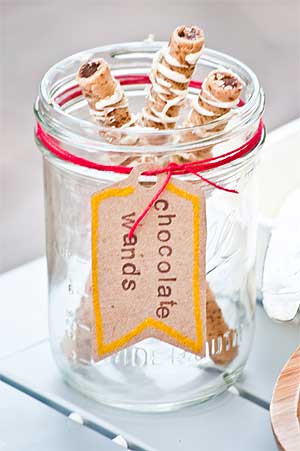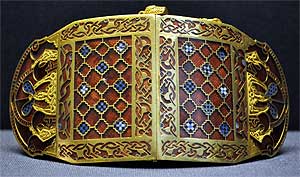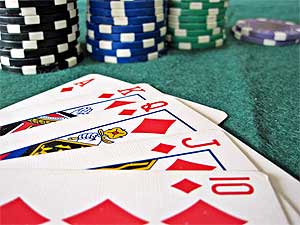 Want to add a little spice to your old-school game? How about something unusual that won’t contribute too much to a character’s power base? Here’s an idea: link two magic items of the same type to a shared pool of charges.
Want to add a little spice to your old-school game? How about something unusual that won’t contribute too much to a character’s power base? Here’s an idea: link two magic items of the same type to a shared pool of charges.
I’ve recently been going through some of my old game files from way back and I thought I’d share some of the ideas from my days of running 1st edition AD&D. This is a magic item, or rather pair of magic items, that allowed me to add a twist to my campaign.
How twinned items work
The twinned magic consists of two magic items of the same type (both rings or rods, etc.). Each item of the pair can perform a separate type of magic–for example, you could link a wand of fire and a wand of lightening, but you couldn’t link a ring of protection and a wand of enemy detection. Take the number of charges each item has separately and add them together. That’s the total number of charges the two items have to share.
For example, if the wand of fire had 50 charges and the wand of enemy detection had 65 charges, both items would share a pool of a 115 charges. They could draw from the pool equally until the total number of charges ran out. That means the wand of fire could potentially be fired 115 times, as long as the wand of enemy detection was never used.
Of course, the fun comes when a PC possesses one of the linked items. Most commonly, a party would find one item in a treasure hoard, not realizing it was linked to another magic item elsewhere in the game world. In this situation, the pool of charges linked to the item in the PCs’ possession will have randomly lost 0-5 charges (1d6-1) since the last time they used it. (Not that the players will necessarily know this).
If both items are used simultaneously, one of the them will not work. If the PCs have only one item, give their item a 15% chance of not working because its linked twin is also being used. If this is the case, nothing happens and no charges are deducted from the shared pool.
Frequently, a party won’t realize that there’s anything unusual about their wand (other than, possibly, intermittent “glitches”) until they try to recharge it. They will be unable to recharge it without its twinned item also present. You can make it difficult for the PCs to determine the reason by requiring the use of some type of divination spell. And even if they discover the nature of the their item, it should require a quest of some sort to find the twinned item.
Creating twinned items
Linked items give magic-users an advantage, in that they’re quicker to create than two completely independent items. Creating a set of twinned items takes less time than it would take to create each item independently. If you chose, you could also discount the materials cost.
Use the creation method described in the 1st ed. AD&D Dungeon Master’s Guide (pp. 87-88) with the following changes:
The items to be enchanted are obtained and prepared normally, as if you were creating two completely separate items, following the instructions given on p. 87, Finding the Right Materials and Preparing the Materials. Once the MU has prepared the items to receive magic, he can begin the process of enchanting them. He needs to touch both items, simultaneously and continuously, during the entire enchanting step and while casting the link spell (described below). The casting time for the enchant an item spell on both items is 24 hours plus 8d8 additional hours.
Immediately after casting the enchant an item spell, the magic -use must cast a link spell. Again, he must touch both items simultaneously and continuously during this stage of the process, which takes 8 + 2d8 hours. This step creates the pool of charges the two items will share.
Only after casting the link spell, does the MU place the desired individual magics in each of the items, as described in the DMG. The desired magics are cast on each item individually, as if the he were creating two separate items. The number of charges in the shared pool equals the total number placed in each item, added together.
For example, Elsa the Enchanter creates two linked items: a wand of frost and a wand of magic detection. She places 20 charges in the wand of frost and 13 in the wand of magic detection, creating a total combined pool of 33 charges which can be used by either wand.
Recharging Twinned Items
To recharge a linked pair, the magic-user must have both items within 1′ of her during the entire recharging process, even if she only wants to recharge one of them. Any attempt to recharge an item without its twin present will cause the the process to fail and any time and/or material components used are lost. Otherwise, recharging proceeds as outlined in the DMG, p. 88.
The MU can cast cast the recharge on only one of the items, but both items must make the required saving throw individually. If either one of the items fails its saving throws during recharging both items crumble to dust.
Spell description
Link (Enchantment/ Alteration)
Type: Magic-User
Level: 6
Range: Touch
Components: V, S, M
Duration: Special
Area of Effect: 2 items
Saving Throw: neg.
This spell links two items with a common pool of shared charges. After successfully casting enchant an item on the items, the magic-user casts a link spell. Both items to be linked must be touched simultaneously by the caster. This touch must be constant and continuous during the casting time, which is 8 + 2d8 hours.
Once the spell is finished, the magic-user can cast the desired spell on the items, one at a time. The total number of charges available to both items is equal to the number of charges cast on each item, added together. Note that this link doesn’t allow the items to share powers, only charges.
The material components for this spell are two items to be enchanted. These items are not consumed in the course of the spell.

















